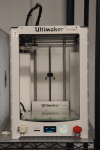A Three-dimensional Printed Low-cost Anterior Shoulder Dislocation Model for Ultrasound-guided Injection Training
- PMID: 30648069
- PMCID: PMC6318112
- DOI: 10.7759/cureus.3536
A Three-dimensional Printed Low-cost Anterior Shoulder Dislocation Model for Ultrasound-guided Injection Training
Abstract
Anterior shoulder dislocations are the most common, large joint dislocations that present to the emergency department (ED). Numerous studies support the use of intraarticular local anesthetic injections for the safe, effective, and time-saving reduction of these dislocations. Simulation training is an alternative and effective method for training compared to bedside learning. There are no commercially available ultrasound-compatible shoulder dislocation models. We utilized a three-dimensional (3D) printer to print a model that allows the visualization of the ultrasound anatomy (sonoanatomy) of an anterior shoulder dislocation. We utilized an open-source file of a shoulder, available from embodi3D® (Bellevue, WA, US). After approximating the relative orientation of the humerus to the glenoid fossa in an anterior dislocation, the humerus and scapula model was printed with an Ultimaker-2 Extended+ 3D® (Ultimaker, Cambridge, MA, US) printer using polylactic acid filaments. A 3D model of the external shoulder anatomy of a live human model was then created using Structure Sensor®(Occipital, San Francisco, CA, US), a 3D scanner. We aligned the printed dislocation model of the humerus and scapula within the resultant external shoulder mold. A pourable ballistics gel solution was used to create the final shoulder phantom. The use of simulation in medicine is widespread and growing, given the restrictions on work hours and a renewed focus on patient safety. The adage of "see one, do one, teach one" is being replaced by deliberate practice. Simulation allows such training to occur in a safe teaching environment. The ballistic gel and polylactic acid structure effectively reproduced the sonoanatomy of an anterior shoulder dislocation. The 3D printed model was effective for practicing an in-plane ultrasound-guided intraarticular joint injection. 3D printing is effective in producing a low-cost, ultrasound-capable model simulating an anterior shoulder dislocation. Future research will determine whether provider confidence and the use of intraarticular anesthesia for the management of shoulder dislocations will improve after utilizing this model.
Keywords: 3d printing; anterior shoulder dislocation; emergency medicine; medical simulation.
Conflict of interest statement
The authors have declared that no competing interests exist.
Figures











References
-
- Epidemiology of shoulder dislocations presenting to emergency departments in the United States. Zacchilli MA, Owens BD. J Bone Joint Surg. 2010;92:542–549. - PubMed
-
- The epidemiology of shoulder dislocations. Krøner K, Lind T, Jensen J. Arch Orthop Trauma. Surg;1989:288–290. - PubMed
-
- The incidence and characteristics of shoulder instability at the United States Military Academy. Owens BD, Duffey ML, Nelson BJ, DeBerardino TM, Taylor DC, Mountcastle SB. Am J Sports. Med;2007:1168–1173. - PubMed
-
- Acute management of shoulder dislocations. Youm T, Takemoto R, Park BKH. J Am Acad Orthop Surg. 2014;22:761–771. - PubMed
LinkOut - more resources
Full Text Sources
